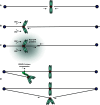Finding the middle ground: how kinetochores power chromosome congression
- PMID: 20232224
- PMCID: PMC2883098
- DOI: 10.1007/s00018-010-0321-y
Finding the middle ground: how kinetochores power chromosome congression
Abstract
Genomic stability requires error-free chromosome segregation during mitosis. Chromosome congression to the spindle equator precedes chromosome segregation in anaphase and is a hallmark of metazoan mitosis. Here we review the current knowledge and concepts on the processes that underlie chromosome congression, including initial attachment to spindle microtubules, biorientation, and movements, from the perspective of the kinetochore.
Figures




Similar articles
-
Kinetochore dynein generates a poleward pulling force to facilitate congression and full chromosome alignment.Cell Res. 2007 Aug;17(8):701-12. doi: 10.1038/cr.2007.65. Cell Res. 2007. PMID: 17680027
-
Leaving no-one behind: how CENP-E facilitates chromosome alignment.Essays Biochem. 2020 Sep 4;64(2):313-324. doi: 10.1042/EBC20190073. Essays Biochem. 2020. PMID: 32347304 Free PMC article. Review.
-
Mechanisms of chromosome biorientation and bipolar spindle assembly analyzed by computational modeling.Elife. 2020 Feb 13;9:e48787. doi: 10.7554/eLife.48787. Elife. 2020. PMID: 32053104 Free PMC article.
-
Merotelic kinetochores in mammalian tissue cells.Philos Trans R Soc Lond B Biol Sci. 2005 Mar 29;360(1455):553-68. doi: 10.1098/rstb.2004.1610. Philos Trans R Soc Lond B Biol Sci. 2005. PMID: 15897180 Free PMC article. Review.
-
Chromosome congression in the absence of kinetochore fibres.Nat Cell Biol. 2009 Jul;11(7):832-8. doi: 10.1038/ncb1890. Epub 2009 Jun 14. Nat Cell Biol. 2009. PMID: 19525938 Free PMC article.
Cited by
-
Evolutionarily conserved protein ERH controls CENP-E mRNA splicing and is required for the survival of KRAS mutant cancer cells.Proc Natl Acad Sci U S A. 2012 Dec 26;109(52):E3659-67. doi: 10.1073/pnas.1207673110. Epub 2012 Dec 10. Proc Natl Acad Sci U S A. 2012. PMID: 23236152 Free PMC article.
-
Springs, clutches and motors: driving forward kinetochore mechanism by modelling.Chromosome Res. 2011 Apr;19(3):409-21. doi: 10.1007/s10577-011-9191-x. Chromosome Res. 2011. PMID: 21331796 Free PMC article. Review.
-
ERH overexpression is associated with decreased cell migration and invasion and a good prognosis in gastric cancer.Transl Cancer Res. 2020 Sep;9(9):5281-5291. doi: 10.21037/tcr-20-1498. Transl Cancer Res. 2020. PMID: 35117894 Free PMC article.
-
Mitotic chromosome alignment ensures mitotic fidelity by promoting interchromosomal compaction during anaphase.J Cell Biol. 2019 Apr 1;218(4):1148-1163. doi: 10.1083/jcb.201807228. Epub 2019 Feb 7. J Cell Biol. 2019. PMID: 30733233 Free PMC article.
-
The enigmatic ERH protein: its role in cell cycle, RNA splicing and cancer.Protein Cell. 2013 Nov;4(11):807-12. doi: 10.1007/s13238-013-3056-3. Protein Cell. 2013. PMID: 24078386 Free PMC article. Review.
References
-
- Waldeyer HWG. Über Karyokinese und ihre Beziehungen zu den Befruchtungsvorgängen. Archiv für mikroskopische Anatomie und Entwicklungsmechanik. 1888;32:1–122.
-
- Flemming W. Beitrage zur kenntnis der zelle und ihrer lebenserscheinungen. Arch Mikrosk Anat. 1879;18:302–436. doi: 10.1007/BF02956386. - DOI
-
- Flemming W (1882) Zellsubstanz, Kern und Zelltheilung. F.C.W. Vogel. Leipzig
-
- Boveri T. Über mehrpolige Mitosen als Mittel zur Analyse des Zellkerns. Verh. d. phys.-med. Ges. 1902;35:67–90.
-
- Sutton WS. The chromosomes in heredity. Biol Bull. 1903;4:231–251. doi: 10.2307/1535741. - DOI
Publication types
MeSH terms
Grants and funding
LinkOut - more resources
Full Text Sources

